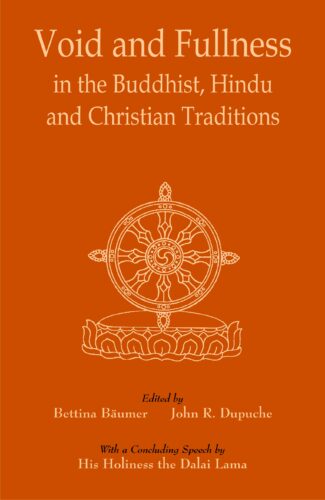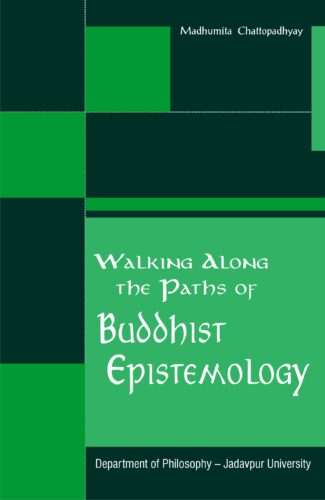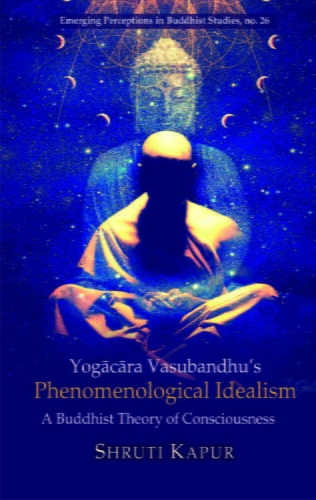Showing 61–66 of 66 results

Interreligious dialogue is one of the important ways for overcoming cultural and religious differences and misunderstandings. But it has to reach the depths of the spiritual, philosophical and theological insights of the religious traditions. This volume throws light on concepts of Void (sunya) and Fullness (purna, in Greek pleroma) in the Buddhist, Hindu and Christian traditions.
Interreligious dialogue is one of the important ways for overcoming cultural and religious differences and misunderstandings, and for contributing to world peace. But such a dialogue has to go beyond the social, institutional and purely academic areas: it has to reach the very depths of the spiritual, philosophical and theological insights of the religious traditions. In Buddhism, Hinduism and Christianity such insights are expressed in the apparently opposite, but in reality complementary concepts of Void (shunya) and Fullness (purna, in Greek pleroma). These concepts lead to the respective spiritual experiences and their interpretations in scriptures and philosophies. This volume contains the papers presented at an interreligious seminar at Sarnath, Varanasi, organised by the Abhishiktananda Society, and inspired by the ideas and life of Swami Abhishiktananda (1910-1973). These papers throw light on these fundamental concepts from the different traditions, and are an invitation to dialogue. H.H. the Dalai Lama gave the concluding speech on the importance of interreligious dialogue.

This is a book on Buddhist epistemology dealing with different epistemological topics like the nature of knowledge, validity of knowledge, knowledge of knowledge, perception, erroneous perception, among others. The author has referred to different Sanskrit texts and literature available on these topics.
The monograph highlights the philosophical arguments offered by Buddhist thinkers on different aspects of knowledge. Various aspects of Buddhist epistemology right from the basic question of what the Buddhists mean by knowledge, the varieties of knowledge according to their belief and their explanations of the validity of knowledge are examined. A painstaking work of Prof. Madhumita Chattopadhyay, this study deals with different epistemological topics like the nature of knowledge, validity of knowledge, knowledge of knowledge, perception, erroneous perception, inference and its related issues like ascertainment of vyapti, antarvyapti, prasanganuman and fallacies of inference. The author has referred to many primary sources which include different Sanskrit texts as well as the latest secondary literature available on these topics and discusses the important role of concept of absence and the theory of apoha or negative nominalism as a substitute for universals in Buddhist metaphysics. An attempt is made to explore whether solutions to modern epistemo-logical problems as found in the Western tradition can be provided from the Buddhist perspective in order to show that Buddhist epistemology has a relevant role to play in the area of epistemology itself. The book would interest scholars and students interested in the epistemological and logical aspects of Buddhist philosophy.

A selection of papers presented at a global congress on World’s Religions after September 11, stressing the need for various religions to develop a better understanding of each other. The papers deal with Islamic, Christian, Bahai, Sikh, Primal and Hindu religious traditions and beliefs.
The volume is concerned with the role of religion in the present day. Presenting proceedings of a global Congress on Worlds Religions after September 11 held in September 2006 at Montreal, Canada, it stresses the need for interfaith friendships to develop understanding between faiths and remove stereotypes that have emerged concerning religious beliefs and their followers. Examining the thoughts of Western theologians and others on the role of religion, it discusses spirituality as being at the root of tolerance. The papers refer to Islamic, Christian Mennonite, Bahzi, Sikh and Hindu religious traditions and beliefs but bear specific reference to the North American Roman Catholic Retreat Centre at Pembroke, Ontario, Canada. They engage in examining specific topics pertaining to the different religious faiths and traditions. They examine the life of Guru Arjan Dev and his message and its significance today, the work of Mira Behn towards conserving the environment of the Himalayas, and the indigenous Australian Christian womens perception. The book provides a glimpse into the life, work and experiences of the spiritual women of Ramanashrama at Tiruvannamalai in Tamil Nadu and Ramanas views on womans right to spirituality, asceticism and salvation. It showcases the contribution of the Inter-religious Council of Central New York towards bringing people of different faiths and cultures into situations of mutual respect and trust. The volume includes the text of the Universal Declaration of Human Rights.

This book is a comparative study of the phenomenology of Yogacara Vasubandhu and that of the German philosopher Edmund Husserl having the focus on the understanding of the deeply inner nature of consciousness or mind. It asserts that the Yogacara philosophy is much richer and comprehensive than the Western phenomenology, particularly the Husserlian phenomenology.
This book is a comparative study of the phenomenology of Yogacara Vasubandhu and that of the German philosopher Edmund Husserl having the focus on the understanding of the deeply inner nature of consciousness or mind. It articulates that the Yogacara philosophy is much richer and comprehensive than the Western phenomenology, particularly the Husserlian phenomenology.
Later Vasubandhu’s philosophical orientation was idealist in Indian sense or a phenomenologist in Husserlian sense. His Mahayana Yogacara idealism is based on Asanga’s seminal text Sandhinirmocanasutra and his own Vijnaptimatratasiddhi (Vimsatika and Trimsika together) along with his exploration of the intrinsic theory of consciousness or mind. For one to have a clear-cut understanding of Vasubandhu, the book follows the Husserlian phenomenological approach as a philosophical methodology and also used select terminology wherever required.
This book is expected to be highly useful for students, researchers and teachers in the area of Indian/Buddhist philosophy.
This book is a comparative study of the phenomenology of Yogacara Vasubandhu and that of the German philosopher Edmund Husserl having the focus on the understanding of the deeply inner nature of consciousness or mind. It asserts that the Yogacara philosophy is much richer and comprehensive than the Western phenomenology, particularly the Husserlian phenomenology.

This book vividly describes how one can achieve samadhi through transforming sex. It unveils the mystery of gods and goddesses and the worshipping of Shiva-lingam. It delves on topics such as why is sex sacred, kundalini and how to raise it, and the connection between sex and spirituality. It enlightens one how to keep the flame of love ever lit in a marriage and achieve the union of heart, mind and soul. It discovers the fountain of youth, a secret guarded for centuries.
Zen Kamasutra is loaded with esoteric wisdom on how to achieve samadhi through transforming sex. It uncovers the mystery of gods and goddesses, why Hindus worship the Shiva Lingam and why is sex sacred? What is Kundalini? How and why to raise the Kundalini? It explains the much-guarded secret of the gods the connection between sex and spirituality. It enlightens one on how to keep the flame of love ever lit in a marriage and achieve a union of heart, mind and soul. It clears up questions that a spiritual seeker has on mysteries of life and death. Also discover here the fountain of youth, another secret, guarded for centuries.
The book would appeal to all those who want to grow spiritually whilst perceiving their journey to be rational and logical. Apply the recommended practices to experience the magic yourself. This book also throws light on chakras by revealing that different chakras govern different qualities like leadership, wisdom, love, communication skills, creativity and intelligence, which can be developed.

इस ग्रन्थ का मुख्य विषय नरक, पशु, प्रेत, मनुष्य, और देव नामक पाँच गतियों में कर्म के आधार पर होने वाले प्राणियों के जन्म का कारण तथा वहाँ होने वाले सुख और दुःख को सरल भाषा, पारलौकिक विषय-वस्तु, एवं कुछ अतिरजनाओं के साथ बतलाना है।
पञ्चगतिदीपनी पालि ब्रह्माण्डीय साहित्य (Pāli Cosmological Literature) का एक महत्त्वपूर्ण ग्रन्थ है। मुख्यतः पञ्चगतिदीपनी बौद्ध-संस्कृत ग्रन्थ षड्गतिकारिका का पालि भाषान्तर है। परम्परा के अनुसार बौद्ध महाकवि अश्वघोष को षड्गतिकारिका का रचनाकार माना जाता है। भारत में इस ग्रन्थ का सम्बन्ध वात्सीयपुत्रीय-सम्मितीय सम्प्रदाय से था। कालान्तर में नौवीं से बारहवीं शताब्दी के बीच षड्गतिकारिका का चीनी, तिब्बती, एवं पालि में भाषान्तर किया गया। षड्गतिकारिका का भाषान्तर पालि में सबसे पहले छगतिदीपनी के नाम से बारहवीं शताब्दी के आसपास म्यांमार (बर्मा) में किया गया। पुनः इस ग्रन्थ को थेरवाद परम्परा-सम्मत बनाने के लिए छगतिदीपनी से पञ्चगतिदीपनी के रूप में पुनरुद्धार किया गया। सम्प्रति पाँच कण्ड में विभाजित पञ्चगतिदीपनी में 114 गाथाएं हैं। इस ग्रन्थ का मुख्य विषय नरक, पशु, प्रेत, मनुष्य, और देव नामक पाँच गतियों में कर्म के आधार पर होने वाले प्राणियों के जन्म का कारण तथा वहाँ होने वाले सुख और दुःख को सरल भाषा, पारलौकिक विषय-वस्तु, एवं कुछ अतिरजनाओं के साथ बतलाना है। प्रस्तुत आलोचनात्मक संस्करण पञ्चगतिदीपनी का देवनागरी पाठ, हिन्दी अनुवाद, टिप्पणी, मूल स्रोत, एवं भूमिका के रूप में पालि ब्रह्माण्डीय साहित्य पर एक विशद विवरण प्रस्तुत करता है।